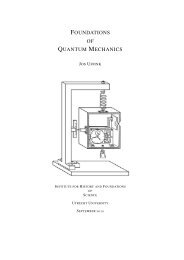Subjective probability and statistical physics
Subjective probability and statistical physics
Subjective probability and statistical physics
You also want an ePaper? Increase the reach of your titles
YUMPU automatically turns print PDFs into web optimized ePapers that Google loves.
possible events. What the principle dem<strong>and</strong>s, therefore, is that if there happens to<br />
be a symmetry in our judgment, it should be reflected by a symmetry in the <strong>probability</strong><br />
assignment. The principle is therefore not circular at all. Another question<br />
might be by what criteria we can reach the verdict that there is a symmetry in our<br />
judgment. This question, unfortunately, seems to lead to a general weakness in symmetry<br />
principles. Even the most sophisticated discussions of symmetry principles<br />
in <strong>physics</strong> or mathematic today state that a symmetry is an operation that leaves<br />
some ”relevant” structure invariant, but without telling us when or why or by what<br />
criteria to determine what is <strong>and</strong> what is not ”relevant”. In the case at h<strong>and</strong>, i.e. the<br />
symmetry being an invariance of an epistemic judgment under the permutation of<br />
possible events, there might be several sources for such criteria: logical, conventional,<br />
empirical, etc.<br />
Let us return to the history. Applications of the Principle of Insufficient Reason<br />
can be found throughout the early history of <strong>probability</strong> theory, long before the<br />
principle was named. For example, Huyghens argued that cases that happen ”equally<br />
easy” have equal <strong>probability</strong> – but without specifying what he meant by the ease of<br />
happening.<br />
Bernoulli was quite familiar with this type of argument, <strong>and</strong> argued, in what I<br />
take to be one of the most penetrating <strong>and</strong> insightful passages of his book, that it<br />
serves us well in all problems of games of chance. For the inventors of such games,<br />
Bernoulli argued, have designed such games such that only a given number of mutually<br />
exclusive possible events can occur, <strong>and</strong> that they all happen “equally easy”. No<br />
doubt, Bernoulli is referring here to the fact that games of dice typically use cubical<br />
dice, so that the number of possible faces is fixed <strong>and</strong> rule that they must be shaken<br />
before being thrown. In card games, the number of cards in the deck is fixed <strong>and</strong><br />
they are to be thoroughly shuffled before the game commences. Somehow these<br />
requirements warrant the conclusion that we shall have no reason to favour one face<br />
of the die above another, or any card being drawn from the deck above any other<br />
card.<br />
However, Bernoulli’s goal is to extend the calculus for games of chance to a more<br />
universal theory of <strong>probability</strong> that would be applicable in the areas of civil, moral,<br />
<strong>and</strong> economic affairs. And he was skeptical about the universal applicability of the<br />
above type of reasoning in such general problems. What if the number of possible<br />
cases is not fixed beforeh<strong>and</strong>, or if no shuffling or shaking mechanism is in place?<br />
Consider, as he did, a case outside of the realm of games of chance, the case of Titius,<br />
say, a healthy <strong>and</strong> abled-bodied man of 40 years. What is the <strong>probability</strong> that Titius<br />
would die in the next ten years? Bernoulli considers what it would take to apply the<br />
principle here:<br />
“ But what mortal, I ask, could ascertain the number of diseases, couting<br />
all possible cases, that afflict the human body in every one of its many<br />
parts <strong>and</strong> at every age, <strong>and</strong> say how much more likely one disease is to<br />
be fatal than another —plague than dropsy, for instance, or dropsy than<br />
fever— <strong>and</strong> on that basis make a prediction about life <strong>and</strong> death in future<br />
generations? [. . . ] [I]t would be quite pointless to proceed along this<br />
road.” (translation: Newman, 1956 Vol 3, pp. 1452-3).<br />
He therefore distinguished between an a priori <strong>and</strong> an a posteriori method of as-<br />
4
















